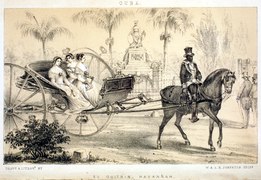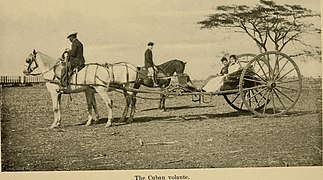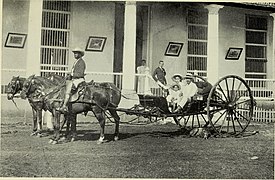Volante (carriage)
Jump to navigation
Jump to search
Volante (volanta in Spanish) is a two-wheeled open carriage with a retractable hood that was popular in Cuba in the mid-1800s. The vehicle was directed by a postilion rider. The large wheels are positioned behind the seat and are over 6 feet in diameter with an 8.5 inch hub. Most of the volantes were imported to Cuba from England, France, or the United States.[1][2][3]
- Volantas
-
Havana, Cuba, 1830s-1840s
-
c. 1900
-
1904
-
3-horse volante, 1899
References
- ^ Smith, D.J.M. (1988). A Dictionary of Horse Drawn Vehicles. J. A. Allen & Co. Ltd. p. 169. ISBN 0851314686. OL 11597864M.
Volante. Two-wheeled, hooded vehicle of Cuba. Fairly lowslung with a chaise-like body and long, flexible shafts, which aided the suspension and eliminated sway. Three or more ponies were harnessed abreast, two on each side of a carriage pole. One of the nearside ponies was further attached by extension gear and ridden by a postillion. Hung on rearward cee springs. Large numbers of this type of vehicle were constructed in either Great Britain or the United States of America exported to Cuba throughout the greater part of the 19th century.
- ^ Walrond, Sallie (1979). The Encyclopaedia of Driving. Country Life Books. p. 290. ISBN 0600331822. OL 4175648M.
Volante: A Cuban two-wheeled hooded vehicle. The wheels are positioned at the end of the shafts, well behind the gig-shaped body which hangs on cee-springs.
- ^ Stratton, Ezra M. (1878). The World on Wheels; or, Carriages, with their Historical Associations from the Earliest to the Present Time, Including a Selection from the American Centennial Exhibition. New York: The author. pp. 427–428. OCLC 3570369. OL 7004294M.
![]() Media related to Volanta at Wikimedia Commons
Media related to Volanta at Wikimedia Commons



